The Future of Aviation Law: Trends and Innovations Shaping the Industry
IH
Introduction to Aviation Law
The aviation industry is constantly evolving, and with it, the legal frameworks that govern it. As technology advances and new challenges arise, aviation law must adapt to ensure safety, efficiency, and innovation. This blog post explores the future of aviation law, focusing on emerging trends and innovations that are shaping the industry.

Technological Advancements in Aviation
One of the most significant drivers of change in aviation law is technology. Innovations such as unmanned aerial vehicles (UAVs), also known as drones, are transforming the industry. These new technologies require updated regulations to ensure they are integrated safely into airspace and do not pose risks to manned aircraft.
Additionally, artificial intelligence (AI) and machine learning are being incorporated into aircraft systems to enhance safety and efficiency. Aviation law must address these technological advancements by establishing guidelines for their use, ensuring they comply with existing safety standards.
Regulations for UAVs
With the increasing use of drones for commercial and recreational purposes, regulatory bodies must implement comprehensive frameworks to manage their operation. This includes rules on airspace access, privacy concerns, and registration requirements. By doing so, lawmakers can help mitigate potential risks while encouraging innovation in drone technology.

Sustainability and Environmental Concerns
As the aviation industry grows, so does its impact on the environment. The future of aviation law will likely focus on addressing these environmental concerns, promoting sustainability through regulations that encourage the reduction of carbon emissions and the use of alternative fuels.
Governments and international bodies are working together to implement policies that support sustainable aviation practices. These efforts include the development of carbon offset programs and incentives for airlines to invest in cleaner technologies.
Carbon Emission Reduction Initiatives
To combat climate change, the aviation industry is exploring various initiatives to reduce carbon emissions. This includes adopting more fuel-efficient aircraft designs, utilizing biofuels, and implementing carbon pricing mechanisms. Aviation law will play a crucial role in supporting these initiatives by establishing clear guidelines and standards for compliance.

Global Collaboration in Aviation Law
Aviation is a global industry, requiring international cooperation to ensure safety and efficiency across borders. Organizations such as the International Civil Aviation Organization (ICAO) work to harmonize regulations worldwide, facilitating seamless air travel.
As new challenges emerge, such as cybersecurity threats and geopolitical tensions, global collaboration becomes even more critical. Aviation law must evolve to address these issues, fostering international partnerships that enhance security and promote peaceful airspace use.
Challenges in Harmonizing Regulations
Despite efforts to standardize aviation regulations globally, challenges remain. Differences in legal systems, economic interests, and political agendas can hinder progress. However, continued dialogue and collaboration among nations are essential for overcoming these barriers and achieving a unified approach to aviation law.

Conclusion
The future of aviation law is dynamic and multifaceted, shaped by technological advancements, environmental concerns, and global collaboration. As the industry continues to evolve, legal frameworks must adapt to ensure safety, efficiency, and innovation. By staying informed about emerging trends and participating in international efforts, stakeholders can help shape a sustainable and secure future for aviation.